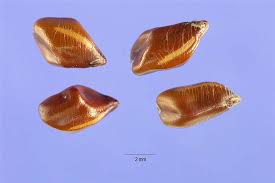http://www.sidhhaherbs.blogspot.com
Senna obtusifolia CHINESE SENNA
 Sicklepod (Senna obtusifolia) is a leguminous plant that infests soybean fields in the southeastern United States. Its seeds contain a variety of toxic, highly colored compounds, mainly anthraquinones together with a small amount of fat. These compounds contaminate and lower the quality of soybean oil when inadequately cleaned soybean seed from this area is processed. The sorting of sicklepod seed from a soybean harvest is an additional economic burden on the farmer beyond the cost of proper disposal of the weed seed to avoid worsening field infestation. Fortunately, sicklepod seed also contains substantial amounts of carbohydrates and proteins. These edible components when freed from anthraquinones have a market in pet food as well as potential in human foods because of the high galactomannan ratio of the polysaccharides. Sicklepod seed was dehulled, and the ground endosperm was defatted, followed by sequential solvent extraction of the defatted seed meal to isolate the anthraquinones, carbohydrates, and protein components into their respective classes. Each class of isolate was spectroscopically identified. Thanks, NCBI resource
Sicklepod (Senna obtusifolia) is a leguminous plant that infests soybean fields in the southeastern United States. Its seeds contain a variety of toxic, highly colored compounds, mainly anthraquinones together with a small amount of fat. These compounds contaminate and lower the quality of soybean oil when inadequately cleaned soybean seed from this area is processed. The sorting of sicklepod seed from a soybean harvest is an additional economic burden on the farmer beyond the cost of proper disposal of the weed seed to avoid worsening field infestation. Fortunately, sicklepod seed also contains substantial amounts of carbohydrates and proteins. These edible components when freed from anthraquinones have a market in pet food as well as potential in human foods because of the high galactomannan ratio of the polysaccharides. Sicklepod seed was dehulled, and the ground endosperm was defatted, followed by sequential solvent extraction of the defatted seed meal to isolate the anthraquinones, carbohydrates, and protein components into their respective classes. Each class of isolate was spectroscopically identified. Thanks, NCBI resource
Senna obtusifolia CHINESE SENNA
- Alternative name is Cassia humilis"
அன்பர்களே! காடு போன்று வளரும் இச்செடியைப் பார்த்திருக்கிறீர்களா?இதன் நன்மைகளைக்கீழேபாருங்கள்
Senna obtusifolia (Chinese Senna or Sicklepod) is a legume in the genus Senna, sometimes separated in the monotypic genusDiallobus. It grows wild in North, Central, and South America, Asia, Africa, and Oceania, and is considered a particularly serious weed in many places. It has a long-standing history of confusion with Senna tora and that taxon in many sources actually refers to the present species.
The green leaves of the plant are fermented to produce a high-protein food product called "kawal" which is eaten by many people in Sudanas a meat substitute. Its leaves, seeds, and root are also used in folk medicine, primarily in Asia. It is believed to possess a laxativeeffect, as well as to be beneficial for the eyes. As a folk remedy, the seeds are often roasted, then boiled in water to produce a tea. The plant's seeds are a commercial source of cassia gum, a food additive usually used as a thickener and named for the Chinese Senna's former placement in the genus Cassia. Roasted and ground, the seeds have also been used as a substitute for coffee. In traditional Korean medicine, they are called gyeolmyeongja (결명자) and usually prepared as tea. They are also used in Kampō (traditionalJapanese medicine) where they are called ketsumei-shi (ケツメイシ, 決明子) or by their Chinese name jué míng zǐ (traditional: 決明子,simplified: 决明子).
Abstract
physicianpackiam
http://www.sidhhaherbs.blogspot.com (72)
Comments